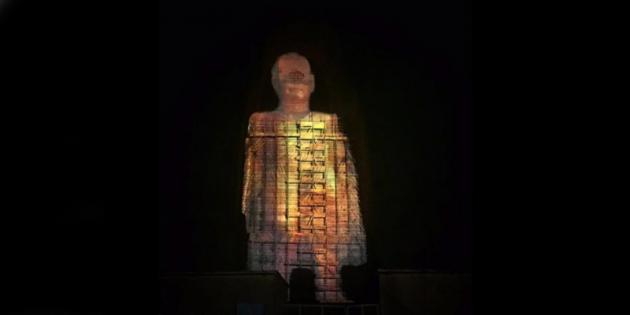There was an international outcry in 2001 when the iconic Buddhas of Bamiyan were dynamited and destroyed by the Taliban, on orders from leader Mullah Mohammed Omar, after the Taliban government declared that they were idols.
Later, an envoy visiting the United States attempted to explain that the statues were destroyed to protest international aid exclusively reserved for statue maintenance while Afghanistan was experiencing famine. While the Afghan Foreign Minister claimed that the destruction was merely about carrying out Islamic religious iconoclasm.

International opinion strongly condemned the destruction of the Buddhas, which in the following years were seen as an example of the extreme religious intolerance of the Taliban. Japan and Switzerland, among others, pledged support for the rebuilding of the sandstone statues, which had often been a target. But this pledge was never fulfilled.
But secretly last weekend, the 6th century Buddhas have been brought back to life via light projections, the Atlantic reports. The statues, that were carved into cliffs in Bamyan Valley, central Afghanistan, left huge niches in the rock faces in which they resided, after being obliterated using explosives in March 2001.
UNESCO declared the ruins a site of World Heritage in Danger, but did not explicitly advocate for reconstruction, since the remnants of the statues were too badly damaged to allow for a complete restoration, even though locals argued that reconstructions would attract tourists, but no agreement was ever reached.
Then two documentarians by the name of Janson Yu and Liyan Hu, came up with a temporary solution in form of holograms. Their 3D projector cast life-size images of the Buddhas into the rock faces where the monuments originally stood. Understandably the projections were not widely publicised, but over 150 people attended the momentous event.
In 1221 with the advent of Genghis Khan “a terrible disaster befell Bamiyan,” nevertheless, the statues were spared by the great warrior. Later, the Mughal emperor, Aurangzeb, tried to use heavy artillery to destroy the iconic statues. Another attempt was made by the 18th century Persian king Nader Afshar, directing cannon fire at them – but again they survived. But in the end a cocktail of modern technology and ignorance saw to their demise.
“Bamiyan” has been translated from Persian as “the place of shining light.” which makes the holograms a fitting tribute the history of the ancient site, and a symbol of hope against religious extremists, and their cultural acts of vandalism – which effects us all.

